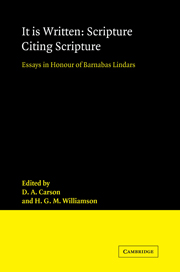Book contents
- Frontmatter
- Contents
- Preface
- Biographical note
- Abbreviations
- 1 An assessment of recent developments
- THE OLD TESTAMENT IN THE OLD TESTAMENT
- BETWEEN THE TESTAMENTS
- 6 Translating the Old Testament
- 7 Retelling the Old Testament
- 8 Commenting on the Old Testament
- 9 Citing the Old Testament
- 10 Apocalyptic literature
- THE OLD TESTAMENT IN THE NEW TESTAMENT
- Indexes
9 - Citing the Old Testament
Published online by Cambridge University Press: 16 January 2010
- Frontmatter
- Contents
- Preface
- Biographical note
- Abbreviations
- 1 An assessment of recent developments
- THE OLD TESTAMENT IN THE OLD TESTAMENT
- BETWEEN THE TESTAMENTS
- 6 Translating the Old Testament
- 7 Retelling the Old Testament
- 8 Commenting on the Old Testament
- 9 Citing the Old Testament
- 10 Apocalyptic literature
- THE OLD TESTAMENT IN THE NEW TESTAMENT
- Indexes
Summary
It is important at the outset to indicate the scope and limitations of this chapter. The main aspects that will be dealt with are scriptural citations, along with allusions to Scripture and developments of biblical themes, in a number of intertestamental texts. These texts, as distinct from those discussed in the other chapters in this section, are not translations or commentaries, based on the biblical text itself, nor do they represent a single genre of literature; correspondingly, the usage of Scripture that they exhibit is not homogeneous. Clearly, therefore, the discussion can only touch on a few texts, and a few points of interest within them; the aim is to provide a survey which is merely illustrative, not comprehensive. The texts which will be discussed and drawn upon are: several of the main Qumran texts (excluding the targumim, Genesis Apocryphon and pesharim, dealt with in the preceding three chapters), specifically: the Damascus Document (CD), the Community Rule (1QS), the War Scroll (1QM), the Hymns Scroll (1QH), and the Temple Scroll (11Q Temple); and several of the so-called apocryphal or deuterocanonical writings: 1 and 2 Maccabees, Tobit, Judith, Ben Sira and Wisdom of Solomon.
In all these texts, specific scriptural citations are relatively infrequent, still more so where they are identified as such by means of an introductory or related formula. Much more common, and in many cases much more interesting, are the allusions of various kinds made to Scripture and the development or reinterpretation of important biblical themes. It is these allusions and developments that are for the most part more indicative than the citations proper of the significance that Scripture has for the writer and his audience.
- Type
- Chapter
- Information
- It Is Written: Scripture Citing ScriptureEssays in Honour of Barnabas Lindars, SSF, pp. 141 - 169Publisher: Cambridge University PressPrint publication year: 1988
- 2
- Cited by

